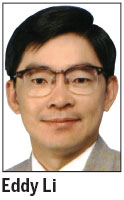Some suggestions to boost economic development in Hong Kong
Updated: 2014-01-23 07:18
By Eddy Li(HK Edition)
|
|||||||||
Over the past year, with more and more political discord in Hong Kong, the emphasis on governance seems to have become very important to many people. But this emphasis, to some degree, overlooks the significance of economic development. The business community - and most of society - is extremely concerned about the drop in Hong Kong's competitiveness. Some people were hoping last week's Policy Address might have attached more importance to the economy. However, the public appear to be disappointed, feeling it lacked adequate economic policies. Moreover, those economic policies which were announced were not specific enough.
Actually, there are some practical measures which could quickly improve the economy and which the government could adopt.
The first is to revise regulations as soon as possible to increase the plot ratio and to relax restrictions on height (for about 20 percent combined), so as to solve the worsening land shortage problem. To my delight, after mentioning this so many times, the 2014 Policy Address, in Paragraph 122, states that "the government considers it feasible to generally increase the maximum domestic plot ratio, currently permitted, for the other 'density zones' in the territory by around 20 percent as appropriate".
Although pleased with the government's decision, I still think this should be applied to more areas. At the moment, residential as well as industrial and commercial buildings face a similar situation. Therefore, I strongly suggest the government extend this relaxation to all construction projects in Hong Kong, including urban renewal, revitalization of industrial buildings, and expansion of hospitals and schools. In addition, individual involvement should be encouraged, too. By doing this, land resources can then be released onto the market, alleviating demand for residential and commercial buildings.

Second, we should promote professional wholesale industries by establishing the first apparel and textiles wholesale market in Cheung Sha Wan. As stated in the Chief Executive's manifesto, the government will take steps to promote wholesale businesses unique to certain districts. In the past year, there have been no government measures in regard to this. Although the Trade and Industry Department did appropriate HK$700,000 to the Hong Kong Chinese Importers' and Exporters' Association for related research, no further measures were introduced by the government after the Hong Kong Polytechnic University finished a research report last November.
I believe we are all aware that the Shum Shui Po district is a garment wholesale center. But due to lack of proper organization by small retailers and schemed developments, the economic performance of the district is still unremarkable. There are many industrial buildings in the area that can be used as a base for design and for exhibitions. Now that the basics are there and the city has good transport and logistics systems, what is needed is for the government to promote the building of a Dongdaemun Market in Hong Kong.
The third measure is to connect Kai Tak and the West Kowloon Cultural Centre with a promenade by building the New Central Harbourfront and launching the Kai Tak Cruise Terminal. This could create a "golden zone" for Hong Kong's tourism industry. The government indicated earlier that a Harbourfront Authority will be set up to manage and develop harbourfront areas. If the new department focuses on "development" instead of "management", businesses will be stimulated, and the population distribution will be more reasonable. This means Hong Kong can receive more tourists.
If the government considers these suggestions and adopts them, Hong Kong's economic development and social stability will benefit greatly.
The author is vice-president of the Chinese Manufacturers' Association of Hong Kong.
(HK Edition 01/23/2014 page1)